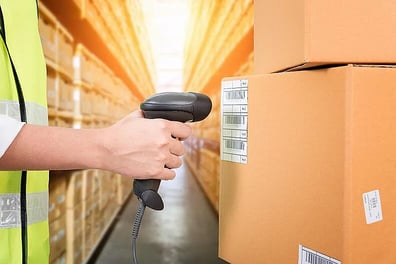Although the idea of a barcode system originated in 1932, the first barcode scanned a pack of Wrigley’s chewing gum in 1974 at an Ohio supermarket. Since then, optical markings have become the most commonly used method for asset identification. Each marking embeds information in a specific pattern that machines and cameras are programmed to recognize. Because barcodes are so inexpensive, they are used to identify commodities.
To a certain extent, barcode technology can even be used for asset tracking. For example, a cash register has a physical address. Anytime an item is scanned, users can see exactly where that product was at a certain point in time. However, that is the limit of a barcode’s asset tracking capabilities. Here are four reasons why retailers eventually will stop using barcodes.
Human error
Let’s say a customer at a grocery store is buying produce, and the barcode was damaged. The clerk might have to key in a PLU number, thereby introducing the opportunity to enter the wrong code, tap or weigh something incorrectly, or add the incorrect quantity. Even worse, what if the clerk has memorized the wrong code? What if the clerk accidentally rings up the customer for expensive cherries when they actually bought cheap bananas? What if a customer decides not to purchase an item and leaves it at the cash register? What if an item falls off a pallet in a warehouse, and no one notices it? One can see how easily the barcode starts to become insufficient.
Image Recognition Technology
Traditional barcodes have two basic levels. The first is 1D barcodes which can only hold up to 84 characters. Contrast that with 2D barcodes that can hold up to 7,000 characters. (That is about two paragraphs of information on less than a square inch.) An example of 2D technology would be QR codes. But even QR codes have their limitations.
Imagine trying to buy a pack of Oreos, but when the store clerk tries to scan the package, it lacks a barcode, or the barcode is damaged. Instead, the clerk moves the Oreos in front of a scanner with image recognition technology. The system recognizes the traditional blue and white Oreo lettering, and it rings it up while the scanner updates the system with the amount of Oreo packages in the store. Although this might sound a little futuristic, image recognition is already a reality and has a strong potential to replace traditional barcodes.
Another step in image recognition technology is image barcodes. With this technology, the entire package has an imperceptible barcode embedded on the surface. Although items will no longer appear to have barcodes, store clerks will scan items faster without looking for the traditional barcode.
Just Walk Out Technology
If you thought image recognition technology was cool, AmazonGo takes it to the next level. Aside from the QR code on a cellphone app that a customer uses to get in the store (now Amazon can track customers), there are no barcodes on any products. This free-checkout experience uses the same types of technologies found in self-driving cars. Computer vision, sensor fusion, and deep-learning help AmazonGo know when a specific item has been picked up or returned to the shelf. The question is, how does AmazonGo decide which customer picked up a particular item? The answer is facial recognition and Radio-frequency Identification (RFID) readers. Once the system identifies which customer picked up that item, it can place that product into a virtual shopping cart. The customer is free to walk around the store with the item in hand. However, once they leave the store, their virtual shopping cart is charged.
RFID Technology
When it comes to cheap retail items, image recognition and just walk-out technology can mitigate human errors. However, as the value of a product increases, identifying an asset becomes insufficient, and the need for locating assets becomes valuable. Here is where RFID technology can step in to create added value. The first type of RFID technology is passive RFID. Although Passive RFID tags have no internal battery, they can transmit data up to 30 feet when they receive an electromagnetic signal from an energized reader. Other times they are silent, and the location is unknown. The second type of RFID tag is active RFID. Active RFID tags have batteries that can increase the ability to transmit data up to 1,500 feet. There are two basic types of Active RFID tags.
- Beacons – transmit data in regular intervals. They even can be used for continuous visibility. The more distance needed to relay the data, the more battery power.
- Transponders – are similar to passive RFID because they only transmit data after receiving a signal. Because transponders relay information on an as-needed basis, their batteries last a lot longer than beacons.
Although it is possible to track assets with RFID tags, they are predominately applicable to identifying assets from great distances. When used for asset tracking, there needs to be a significant quantity of readers. Even with continuous visibility, RFID tags are not capable of tracking in real-time.
To Wrap It Up
Traditionally, a retailer would have to walk around in the store or warehouse and scan an item or piece of equipment and then record it onto a spreadsheet. Today most organizations benefit from using asset management software to and identify assets and even track assets. These centralized systems can take the information from an RFID tag and limit human error while improving data quality. Asset tracking systems using RTLS solutions can increase understanding of purchasing trends, and it can help with the relocation of equipment. Here at Link-Labs, we specialize in cost-efficient asset tracking and identification. If you need help taking a step into the future of retail, then please do not hesitate to reach out…
And, to get the full history of asset tracking, download our ultimate guide today.




